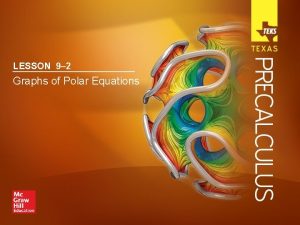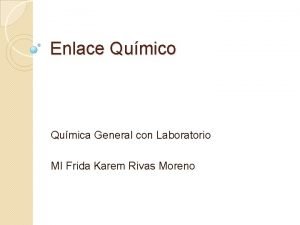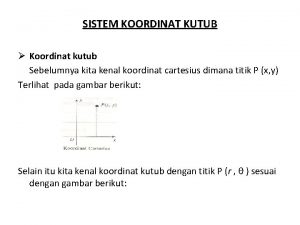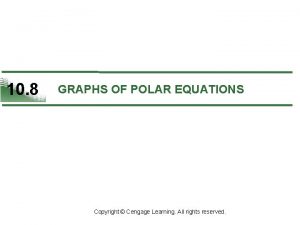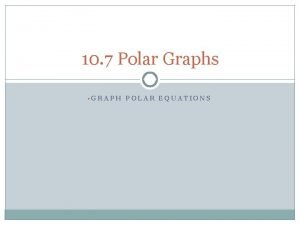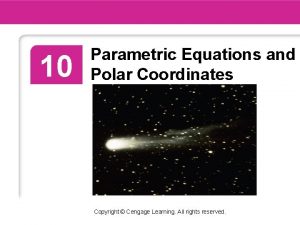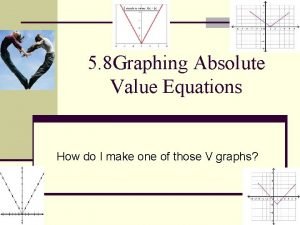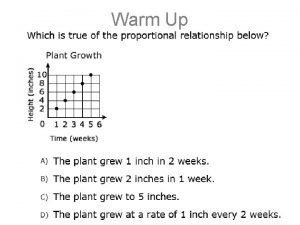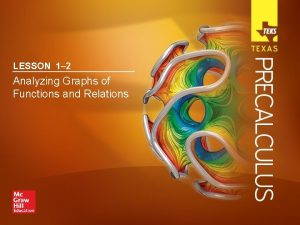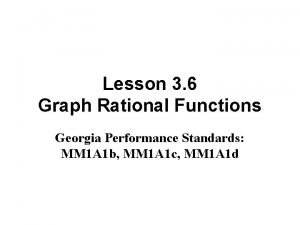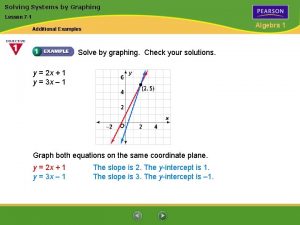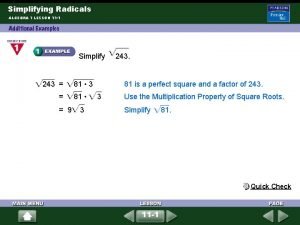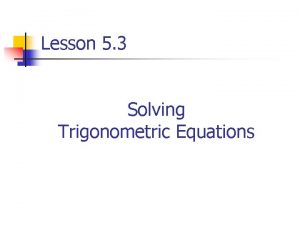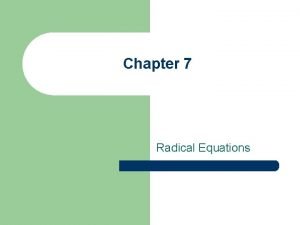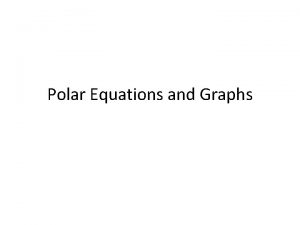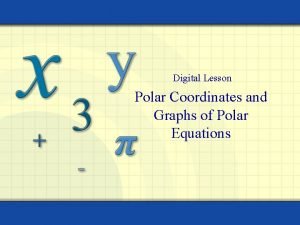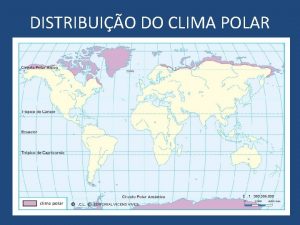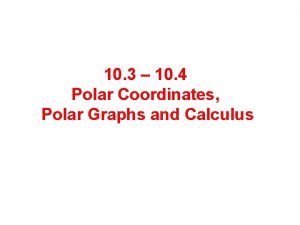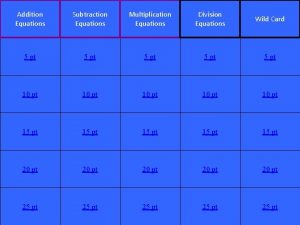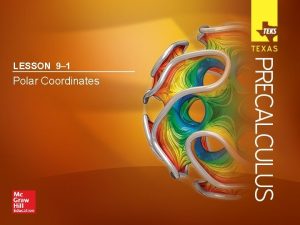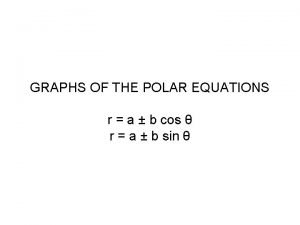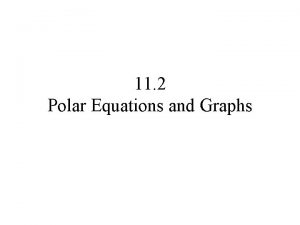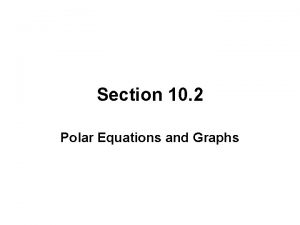LESSON 9 2 Graphs of Polar Equations FiveMinute









































- Slides: 41

LESSON 9– 2 Graphs of Polar Equations

Five-Minute Check (over Lesson 9 -1) TEKS Then/Now New Vocabulary Example 1: Graph Polar Equations by Plotting Points Key Concept: Symmetry of Polar Graphs Example 2: Real-World Example: Polar Axis Symmetry Key Concept: Quick Tests for Symmetry in Polar Graphs Example 3: Real-World Example: Symmetry with Respect to the Line =. Example 4: Symmetry, Zeros, and Maximum r-Values Concept Summary: Special Types of Polar Graphs Example 5: Identify and Graph Classic Curves

Over Lesson 9 -1 Graph S(− 3, 60°) on a polar grid. A. C. B. D.

Over Lesson 9 -1 Find three different pairs of polar coordinates that name A. B. C. D. if – 2π ≤ θ ≤ 2π.

Over Lesson 9 -1 Graph A. C. B. D.

Over Lesson 9 -1 Which of the following represents the distance between (2, 150°) and (4, − 45°)? A. 2. 13 B. 4. 91 C. 5. 95 D. 35. 45

Targeted TEKS P. 3(E) Graph polar equations such as cardiods, limaçons, or lemniscates by plotting points and using technology. Mathematical Processes P. 1(F), P. 1(G)

You graphed functions in the rectangular coordinate system. (Lesson 1 -2) • Graph polar equations. • Identify and graph classical curves.

• limacon ΄ • cardioid • rose • lemniscate • spiral of Archimedes

Graph Polar Equations by Plotting Points A. Graph r = 3 cos θ. Make a table of values to find the r-values corresponding to various values of on the interval [0, 2π]. Round each r-value to the nearest tenth.

Graph Polar Equations by Plotting Points Graph the ordered pairs (r, ) and connect them with a smooth curve. It appears that the graph is a circle with center (1. 5, 0) and radius 1. 5 units. Answer:

Graph Polar Equations by Plotting Points B. Graph r = 3 sin θ. Make a table of values to find the r-values corresponding to various values of on the interval [0, 2π]. Round each r-value to the nearest tenth.

Graph Polar Equations by Plotting Points Graph the ordered pairs and connect them with a smooth curve. It appears that the graph is a circle with center (0, 1. 5) and radius 1. 5 units. Answer:

Graph r = – 4 cos θ. A. C. B. D.


Polar Axis Symmetry Use symmetry to graph r = 1 – 3 cos θ. Replacing (r, ) with (r, – ) yields r = 1 – 3 cos(– ). Because cosine is an even function, cos (– ) = cos , so this equation simplifies to r = 1 – 3 cos . Because the replacement produced an equation equivalent to the original equation, the graph of this equation is symmetric with respect to the polar axis. Because of this symmetry, you need only make a table of values to find the r-values corresponding to on the interval [0, π].

Polar Axis Symmetry Plotting these points and using polar axis symmetry, you obtain the graph shown. This curve is called a limacon with an inner loop. ΄ Answer:

Use symmetry to graph r = 1 + 2 cos . A. C. B. D.


Symmetry with Respect to the Line A. LIGHT TECHNOLOGY The area lit by two lights that shine down on a stage can be represented by the equation r = 1. 5 + 1. 5 sin θ. Suppose the front of the stage faces due south. Graph the polar pattern of the two lights. Because this polar equation is a function of the sine function, it is symmetric with respect to the line Therefore, make a table and calculate the values of r on .

Symmetry with Respect to the Line Plotting these points and using symmetry with respect to the line , you obtain the graph shown. This curve is called a cardioid.

Symmetry with Respect to the Line Answer:

Symmetry with Respect to the Line B. LIGHT TECHNOLOGY The area lit by two lights that shine down on a stage can be represented by the equation r = 1. 5 + 1. 5 sin θ. Suppose the front of the stage faces due south. Describe what the polar pattern tells you about the two lights. Answer: Sample answer: The polar pattern indicates that the lights will light up a large portion toward the back of the stage but will not light up very much past the edge of the stage into the audience.

AUDIO TECHNOLOGY A microphone was placed at the front of a stage to capture the sound from the acts performing during the senior talent show. The front of the stage faces due south. The area of sound the microphone captures can be represented by r = 2. 5 + 2. 5 sin . Describe what the polar pattern tells you about the microphone.

A. The microphone will pick up a large portion of sound toward the back of the stage but not much from the front edge of the stage and audience. B. The microphone will pick up a large portion of sound toward the front of the stage and the audience but not much from the back of the stage. C. The microphone will pick up a large portion of sound on the right side of the stage and audience but not much from the left side. D. The microphone will pick up a large portion of sound on the left side of the stage and audience but not much from the right side.

Symmetry, Zeros, and Maximum r-Values Use symmetry, zeros, and maximum r-values to graph r = 2 sin 2θ. This function is symmetric with respect to the polar axis and the line interval , so you can find points on the and then use symmetry to complete the graph. Sketch the graph of the rectangular function y = 2 sin 2 on the interval

Symmetry, Zeros, and Maximum r-Values From the graph, you can see that |y| = 2 when and y = 0 when x = 0 and .

Symmetry, Zeros, and Maximum r-Values Interpreting these results in terms of the polar equation r = 2 sin 2 , we can say that |r| has a maximum value of 2 when = and r = 0 when = 0 and . Use these and a few additional points to sketch the graph of the function.

Symmetry, Zeros, and Maximum r-Values Answer: Notice that polar axis symmetry can be used to complete the graph after plotting points on This type of curve is called a rose. .

Determine the symmetry and maximum r-values of r = 5 sin 4 for 0 ≤ θ < π. A. symmetric to the line , |r| = 5 when B. symmetric to the polar axis, |r| = 5 when C. symmetric to the line , the polar axis, and the pole, | r | = 5 when D. symmetric to the line the pole, | r | = 5 when , the polar axis, and



Identify and Graph Classic Curves A. Identify the type of curve given by r 2 = 8 sin 2θ. Then use symmetry, zeros, and maximum r-values to graph the function. The equation is of the form r 2 = a 2 sin 2 , so its graph is a lemniscate. Replacing (r, ) with (–r, ) yields (–r)2 = 8 sin 2 or r 2 = 8 sin 2. Therefore, the function has symmetry with respect to the pole.

Identify and Graph Classic Curves The equation r 2 = 8 sin 2 is equivalent to r = which is undefined when 2 sin 2 < 0. Therefore, the domain of the function is restricted to the intervals Because you can use pole symmetry, you need only graph points in the interval The function attains a maximum r-value of |a| or when and zero r-value when x = 0 and .

Identify and Graph Classic Curves Use these points and the indicated symmetry to sketch the graph of the function.

Identify and Graph Classic Curves Answer: lemniscates;

Identify and Graph Classic Curves B. Identify the type of curve given by r = 2θ, θ > 0. Then use symmetry, zeros, and maximum r-values to graph the function. The equation is of the form r = a + b, so its graph is a spiral of Archimedes. Replacing (r, ) with (–r, – ) yields (–r) = 2(– ) or r = 2. Therefore, the function has symmetry with respect to the line However, since > 0, this function will show no line symmetry.

Identify and Graph Classic Curves Spirals are unbounded. Therefore, the function has no maximum r-values and only one zero when = 0. Use points on the interval [0, 4π] to sketch the graph of the function.

Identify and Graph Classic Curves Answer: spiral of Archimedes;

Identify the type of curve given by r = 4 cos 6θ. A. cardioid B. lemniscate C. limacon ΄ D. rose

LESSON 9– 2 Graphs of Polar Equations
 Lesson 9-2
Lesson 9-2 9-3 polar and rectangular forms of equations
9-3 polar and rectangular forms of equations Polar covalent bond animation
Polar covalent bond animation Sustancia polar y no polar
Sustancia polar y no polar Is glycine polar or nonpolar
Is glycine polar or nonpolar Attractions
Attractions What are polar and nonpolar dielectrics
What are polar and nonpolar dielectrics Enlace dativo
Enlace dativo Symmetry in polar coordinates
Symmetry in polar coordinates Grafik persamaan kutub
Grafik persamaan kutub Convex limacon
Convex limacon Common polar graphs
Common polar graphs Special polar graphs
Special polar graphs Jenis graph
Jenis graph Polar equation
Polar equation Zczc state graph
Zczc state graph Graphs that compare distance and time are called
Graphs that compare distance and time are called Graphs that enlighten and graphs that deceive
Graphs that enlighten and graphs that deceive End behavior of polynomials
End behavior of polynomials Parametric equations and polar coordinates
Parametric equations and polar coordinates How to add in polar form
How to add in polar form Rectangular form
Rectangular form Find the constant of proportionality
Find the constant of proportionality Writing linear equations from situations and graphs
Writing linear equations from situations and graphs 5-1 writing linear equations from situations and graphs
5-1 writing linear equations from situations and graphs Absolute value graphing worksheet
Absolute value graphing worksheet Words equations tables and graphs
Words equations tables and graphs Unit 1 lesson 9
Unit 1 lesson 9 Unit 3 lesson 3 rational functions and their graphs
Unit 3 lesson 3 rational functions and their graphs Lesson 11 transforming the graph of the sine function
Lesson 11 transforming the graph of the sine function Lesson 5-2 inverses of functions
Lesson 5-2 inverses of functions Interpreting graphs of proportional relationships
Interpreting graphs of proportional relationships Analyzing graphs of functions and relations worksheet
Analyzing graphs of functions and relations worksheet Lesson 3 rational functions and their graphs
Lesson 3 rational functions and their graphs Translate word equations to chemical equations
Translate word equations to chemical equations Faceing math lesson 4 solving two step equations
Faceing math lesson 4 solving two step equations Lesson 7 solve systems of equations by graphing
Lesson 7 solve systems of equations by graphing Solving rational equations and inequalities
Solving rational equations and inequalities Lesson 11-3 solving radical equations answers
Lesson 11-3 solving radical equations answers Toxic reactions chemical equations
Toxic reactions chemical equations Linear trigonometric equations
Linear trigonometric equations Lesson 7 - graphing radical equations and inequalities
Lesson 7 - graphing radical equations and inequalities
